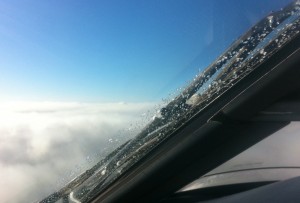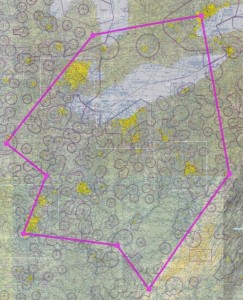 The regulations state that flight into known or forecast light or moderate icing is prohibited unless we have an anti-ice or deice system. What does the FAA consider the word "known" to mean in reference to icing conditions?
The regulations state that flight into known or forecast light or moderate icing is prohibited unless we have an anti-ice or deice system. What does the FAA consider the word "known" to mean in reference to icing conditions?
The Aeronautical Information Manual (AIM) defines known icing conditions as "atmospheric conditions which the formation of ice is observed or detected in flight". If there is a pilot report of icing in an area you are flying through, you are flying into an area of known icing. If you don't have anti-ice or deice equipment you should not fly into this area.
It is easy to determine "known" but how do we determine what is forecast icing?
Due to numerous icing accidents, the FAA has become more conservative in their approach to warning pilots of the possibility of icing conditions. Therefore, icing forecasts include much larger areas describing the possibility of icing conditions.
Since the forecasts have changed to include wider areas of forecast icing many pilots have argued they can still fly into areas of forecast icing. I recommend if there is forecast icing and you have no deice/anti-ice equipment than you should not fly into areas forecast for icing conditions.
My reasoning is twofold. First, it is safer. Second, if you do fly into icing conditions and you are involved in an accident due to the ice accretion on your aircraft, how will you explain your decision to fly into forecast icing conditions during the NTSB hearing?
I do not fly into conditions of forecast icing unless the deice/ant-ice system on my aircraft is installed and working. This is a very conservative approach, but one I feel is the safest.
With that said, I have many well respected colleagues who have safely flown into areas of forecast light icing for many years because they know from experience that icing conditions will be light or nonexistent. I fly through icing conditions on a regular basis and my experience has been that icing conditions can be unpredictable so I take a much more conservative approach to icing and don’t fly into forecast icing unless I have anti-ice equipment.
Even if you do have the ability to fly into known icing it is a good idea to remember the areas where icing conditions do not exist in case your anti-icing system fails. Since I fly in icing conditions on a frequent basis, I have have seen more than my share of anti-icing system failures. When the anti-icing system fails it is good to know what altitude and heading will remove you from the ice.
Example:
You want to fly on an Instrument Flight Rules (IFR) flight at eight thousand feet but the temperature at our airport is zero degrees celsius and there is an overcast layer at seven thousand. Provided you have adequate terrain clearance you should plan to fly at six thousand to avoid the ice.
Making our decision easier we notice there is a pilot report (PIREP) which indicates an aircraft which took off an hour before us encountered light icing from seven thousand to the tops at twelve thousand. We change our planned altitude and depart remaining clear of clouds to avoid icing.
Example:
 You want to fly from Harrisburg Capitol City Airport, PA (CXY) to Pittsburg Allegheny County Airport (AGC) . Using the current forecast we notice our departure should be fine for a flight westbound at six thousand feet, but we will begin to run into trouble as we approach Johnstown VOR (JST).
You want to fly from Harrisburg Capitol City Airport, PA (CXY) to Pittsburg Allegheny County Airport (AGC) . Using the current forecast we notice our departure should be fine for a flight westbound at six thousand feet, but we will begin to run into trouble as we approach Johnstown VOR (JST).
An Airmet (Airmen’s Meteorological Information) for icing exists for an area bound by the area approximating the lines drawn above. An area with layers of clouds and icing begin from twelve thousand feet to the surface near JST. This is probably not a great day to fly due to the icing but let’s look further to see if there are any pilot reports.
Using both graphical forecast tools and printed reports we see a regional jet reported icing over Pittsburgh. The following pilot report translated states: over the Pittsburgh VOR 090 radial and 5 miles at 1430 zulu an EMB 145 regional jet encountered light rime icing at five thousand feet. The temperature outside was -3 celsius and the overcast layer extended from two thousand five hundred to the tops at five thousand feet.
Different types of aircraft collect icing at different rates. A jet flying through an area of icing might encounter light icing whereas a Cessna 172 might encounter moderate icing. Icing first forms on certain surfaces quicker than others, usually small pieces of metal or aircraft structure sticking into the airstream. On one of the jets I fly the icing first becomes noticeable on the bottom of the windshield and on the windshield wipers. It is important to have experience in icing for your type aircraft to detect the first ice accretion.
Conclusion:
Flying in areas of forecast icing takes experience in the type aircraft you fly and should be approached carefully. If you don't have anti-icing or deicing equipment in your airplane you should not fly into areas forecast for icing. Even if you do have anti/deicing equipment installed in your airplane you need to keep in mind where you are going to go in case the system fails. Remember it is always better to over estimate the severity of the icing conditions than to underestimate.
Safe Flying!
For More Information:
91.527 - Operating in icing conditions.


Comments on this entry are closed.
I appreciate your distillation of some complex ideas about known icing into simple English.
However (and I’m not a lawyer) it does appear that PIREPS are trumped by AIRMETS and SIGMETS, in the sense that the absence of a PIREP of icing does not necessarily indicate the lack of known icing conditions.
I’m referencing an article from 2001, http://www.avweb.com/news/airman/184265-1.html?redirected=1
“The Naked Truth About Known Icing Conditions.”
An excerpt:
“We [NTSB] do not construe the adjective ‘known’ to mean that there must be a near certainty that icing will occur, such as might be established by pilot reports. Rather we take the entire phrase to mean that icing conditions are being reported or forecast in reports which are known to a pilot, or of which he should reasonably be aware.” Thus the word “known” refers not to the ice that you “know” about because it is forming right now on some airplane somewhere, but to the information available to the pilot before and during the flight — and that might be any information, including a forecast.”
I suppose that, what I’m getting at is, while PIREPS can help, it might not be a good idea to rely on them–or their absence–too heavily, especially from a legal standpoint.